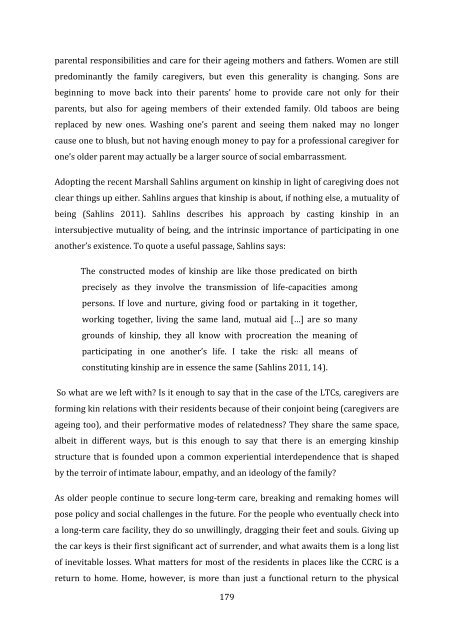Philip Y. Kao PhD thesis - Research@StAndrews:FullText
Philip Y. Kao PhD thesis - Research@StAndrews:FullText
Philip Y. Kao PhD thesis - Research@StAndrews:FullText
Create successful ePaper yourself
Turn your PDF publications into a flip-book with our unique Google optimized e-Paper software.
parental responsibilities and care for their ageing mothers and fathers. Women are still<br />
predominantly the family caregivers, but even this generality is changing. Sons are<br />
beginning to move back into their parents’ home to provide care not only for their<br />
parents, but also for ageing members of their extended family. Old taboos are being<br />
replaced by new ones. Washing one’s parent and seeing them naked may no longer<br />
cause one to blush, but not having enough money to pay for a professional caregiver for<br />
one’s older parent may actually be a larger source of social embarrassment.<br />
Adopting the recent Marshall Sahlins argument on kinship in light of caregiving does not<br />
clear things up either. Sahlins argues that kinship is about, if nothing else, a mutuality of<br />
being (Sahlins 2011). Sahlins describes his approach by casting kinship in an<br />
intersubjective mutuality of being, and the intrinsic importance of participating in one<br />
another’s existence. To quote a useful passage, Sahlins says:<br />
The constructed modes of kinship are like those predicated on birth<br />
precisely as they involve the transmission of life-capacities among<br />
persons. If love and nurture, giving food or partaking in it together,<br />
working together, living the same land, mutual aid […] are so many<br />
grounds of kinship, they all know with procreation the meaning of<br />
participating in one another’s life. I take the risk: all means of<br />
constituting kinship are in essence the same (Sahlins 2011, 14).<br />
So what are we left with? Is it enough to say that in the case of the LTCs, caregivers are<br />
forming kin relations with their residents because of their conjoint being (caregivers are<br />
ageing too), and their performative modes of relatedness? They share the same space,<br />
albeit in different ways, but is this enough to say that there is an emerging kinship<br />
structure that is founded upon a common experiential interdependence that is shaped<br />
by the terroir of intimate labour, empathy, and an ideology of the family?<br />
As older people continue to secure long-term care, breaking and remaking homes will<br />
pose policy and social challenges in the future. For the people who eventually check into<br />
a long-term care facility, they do so unwillingly, dragging their feet and souls. Giving up<br />
the car keys is their first significant act of surrender, and what awaits them is a long list<br />
of inevitable losses. What matters for most of the residents in places like the CCRC is a<br />
return to home. Home, however, is more than just a functional return to the physical<br />
179
















